When the lights go out, you'll be glad you took the time to prepare. A power outage can be more than just an inconvenience – it can be a serious safety risk. By taking proactive steps, you can guarantee your family's well-being and comfort until the lights come back on. You'll need to think about more than just flashlights and batteries, though. You'll want to ponder how you'll cook, communicate, and even stay safe in the dark. So, what do you need to do to be ready when the power goes out?
Summary
- Conduct a risk assessment to identify potential hazards in the home and prioritize preparations based on vulnerability and essential needs.
- Gather essential items, including a flashlight, first aid kit, battery-powered radio, and non-perishable food, and store them in an accessible location.
- Prepare lighting options, such as battery-powered or propane-fueled lanterns, and invest in a battery backup system or portable power bank for phone charging.
- Create a plan that addresses unique household situations, including medical priorities, alternative cooking and heating methods, and communication protocols.
- Practice the emergency plan with regular rehearsals to identify weaknesses, build confidence, and ensure efficient response during an actual power outage.
Assess Your Emergency Needs
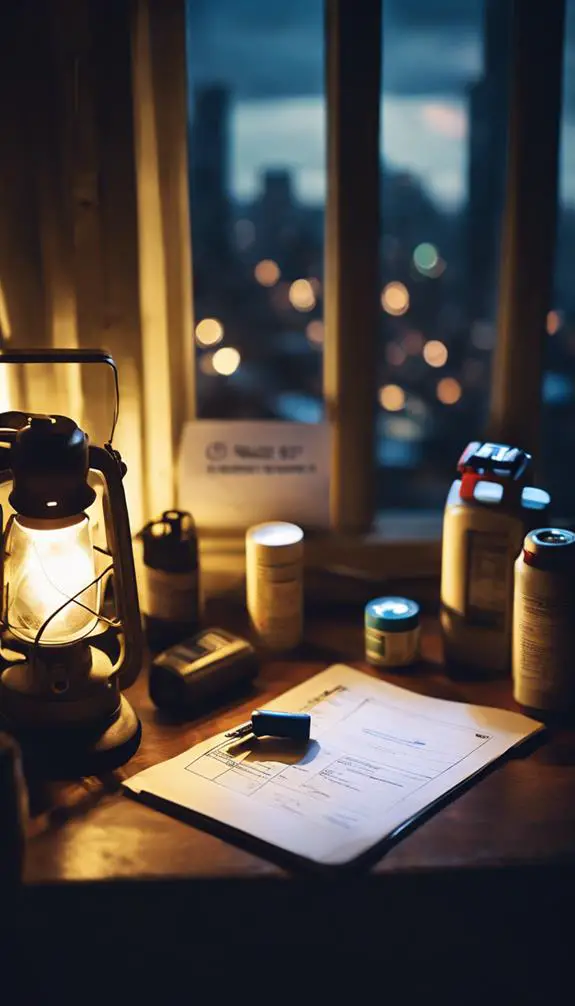
Your flashlight, radio, and first aid kit are all essential items to have ready in case the lights go out, but before you start gathering supplies, take a step back and assess your emergency needs.
Conduct a risk assessment to identify potential hazards in your home, such as electrical sparks or fire risks. Evaluate your vulnerability to these risks, considering factors like the number of people in your household, their ages, and any special needs.
This will help you prioritize your preparations and allocate resources effectively. By understanding your specific emergency needs, you'll be better equipped to create a plan that addresses your unique situation, ensuring you're prepared to respond quickly and confidently when the power goes out.
Create a Power Outage Kit
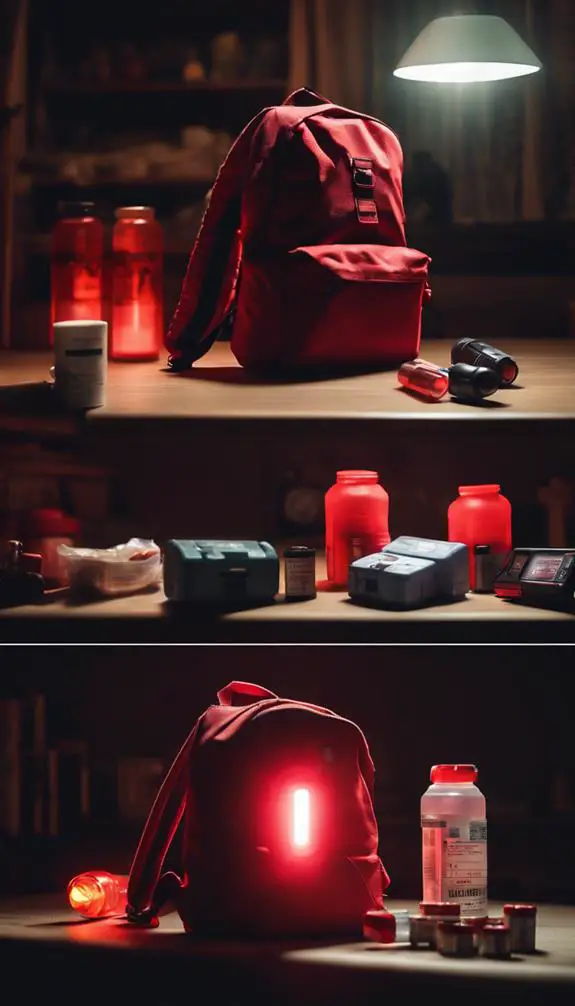
Reliability is key when assembling a power outage kit, as it serves as your lifeline during an emergency.
You'll want to guarantee it's stocked with essentials that'll keep you safe and comfortable until power is restored.
Start by gathering a flashlight, extra batteries, a first aid kit, and a battery-powered radio.
Don't forget a whistle to signal for help if needed, a dust mask, and warm blankets.
Your kit should also include a multi-tool, toilet paper, and a supply of water (at least one gallon per person per day).
Create a kit checklist to guarantee you haven't forgotten anything vital.
Review and update your kit regularly to maintain its effectiveness.
Stock Up on Non-Perishable Foods

You'll need to stock up on non-perishable foods that won't spoil quickly and can be easily prepared without electricity.
Focus on food storage essentials like canned goods, dried fruits and nuts, and energy-dense foods that'll keep you fueled.
Additionally, consider emergency snack options like granola bars, trail mix, and MREs (Meals Ready to Eat) that are compact, lightweight, and easy to consume on the go.
Food Storage Essentials
Three days' worth of non-perishable food storage is a minimum requirement for any household preparing for a power outage.
You'll want to stock up on staples like canned goods, dried fruits and nuts, and energy bars. When selecting food items, pay attention to expiration dates and implement a "first in, first out" food rotation system to guarantee older items are consumed before they spoil.
Store food in a cool, dry place, protected from moisture and pests. Consider the dietary needs and preferences of your household members, including any allergies or special requirements.
Emergency Snack Options
Five easy-to-grab snacks can be a lifesaver during a power outage, providing a quick energy boost to help you navigate the situation.
Stock up on non-perishable foods that are high in calories and nutrients. Consider Snack Rations like nuts, dried fruits, and jerky, which are compact, lightweight, and don't require refrigeration.
Energy Bars are another great option, providing a concentrated source of energy. Look for bars with a long shelf life and minimal ingredients.
Other good options include canned goods like tuna, beans, and soups, as well as MREs (Meals Ready to Eat).
Store your snacks in an easy-to-access location, like a designated emergency bin or a portable backpack. This way, you can quickly grab what you need and focus on getting through the outage.
Store Water for Emergency Use
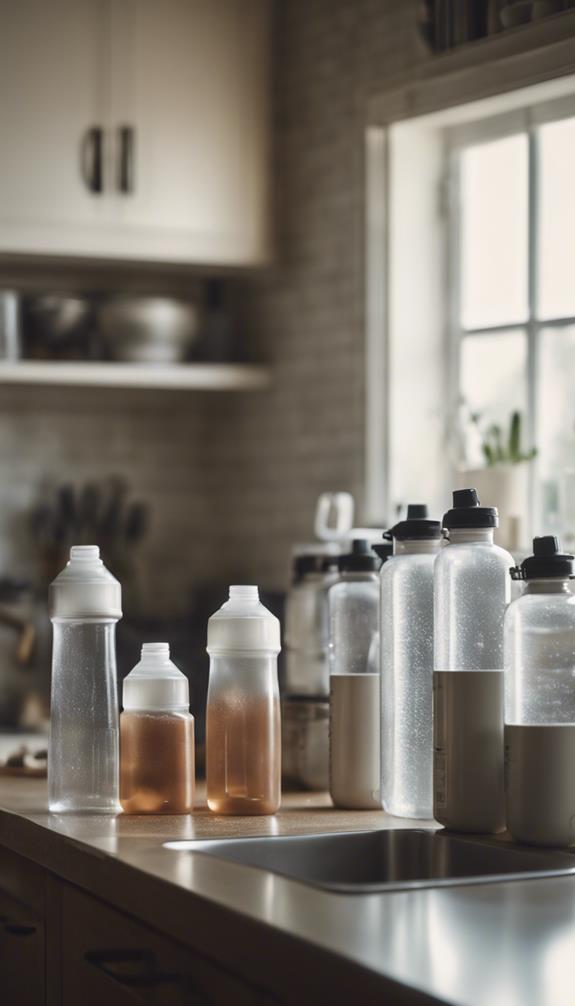
When preparing for a power outage, you'll need to store water in accessible locations, such as basements or closets, to guarantee it's readily available when you need it.
You should also consider methods for purifying water, such as water filters or purification tablets, in case your stored water supply runs out. By planning ahead, you can certify a steady supply of safe drinking water throughout the outage.
Water Storage Locations
A minimum of one gallon per person per day is recommended for storing water in your home, and you'll need to designate suitable locations for this storage.
Consider water cache ideas that keep your supply hidden from view, such as under-bed storage containers or closet shelves. You can also utilize hidden tanks, like those disguised as planters or decorative containers, to store water in plain sight.
Guarantee the storage locations are easily accessible, yet protected from contamination and extreme temperatures. Label each container with the date it was filled and store them in a way that allows you to rotate your supply regularly.
Water Purification Methods
You've stockpiled water, but it's essential to verify it's safe to drink during an emergency.
Contaminated water can be deadly, so purification methods are pivotal. The Boil Method is a reliable way to kill bacteria, viruses, and other microorganisms. Bring the water to a rolling boil for 1-3 minutes to guarantee it's safe.
Another effective method is Solar Disinfection (SODIS). Expose the water to direct sunlight in a clear plastic bottle for at least 6 hours. The UV rays will kill most bacteria and viruses.
Remember to always purify water before consumption to avoid waterborne illnesses. Having a reliable purification method will give you peace of mind and protect your health during a power outage.
Prepare Your Lighting Options

Most households rely heavily on electric lighting, making it essential to prepare alternative lighting options for a power outage.
When selecting lantern options, consider battery-powered or propane-fueled models. Look for lanterns with adjustable brightness, red light modes to preserve night vision, and durable construction.
For flashlights, prioritize LED models with long battery life and water resistance. Regular flashlight maintenance is vital. Check batteries every six months, replacing them as needed.
Clean the lens and reflector to maintain peak light output. Store flashlights in an accessible location, ensuring everyone in your household knows where to find them.
Get a First Aid Kit Ready
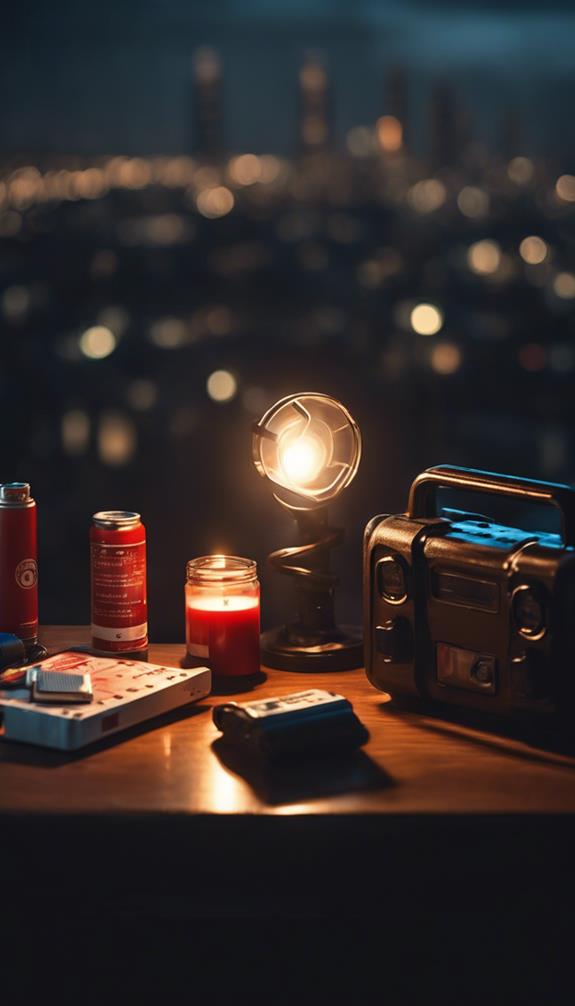
Essential medical supplies are crucial during a power outage, as access to medical facilities may be limited.
You'll want a well-stocked first aid kit that includes Kit Essentials like bandages, antiseptic wipes, pain relievers, and any prescription medications you or your family members may need.
Identify your Medical Priorities, such as treating wounds, reducing fever, and managing chronic conditions.
Don't forget to include a first aid guide or manual, as well as a flashlight or extra batteries in case you need to administer aid in the dark.
Make sure all items are easily accessible and that everyone in your household knows where the kit is located.
Keep Important Documents Safe
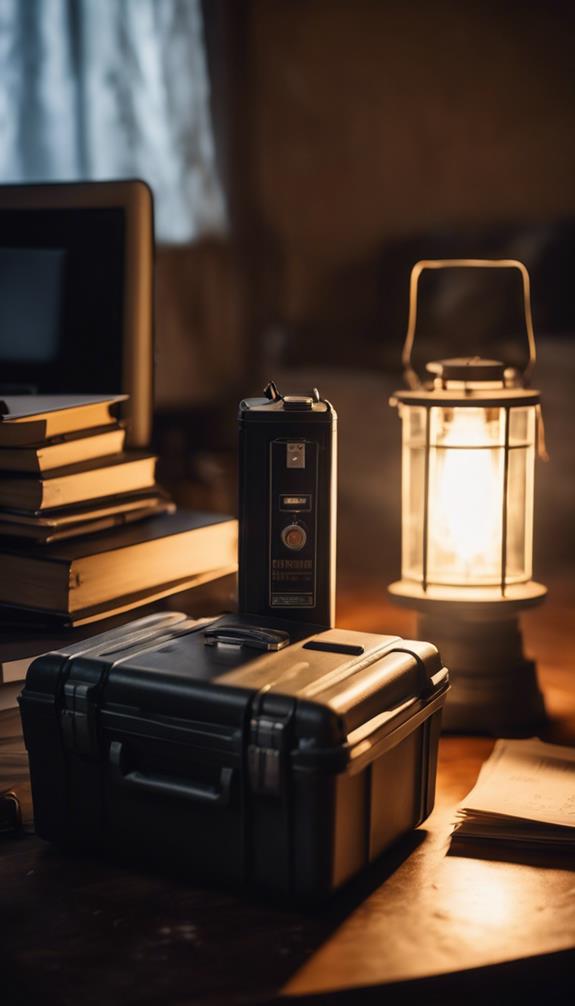
While preparing your first aid kit, you've likely thought about the importance of having critical supplies on hand.
Now, it's time to think about your important documents. In a power outage, you may not have access to them, and that can be a significant problem.
Invest in a document scanner to digitize your crucial documents, such as identification, insurance papers, and financial records. Then, upload them to cloud storage for secure, remote access.
This way, you can access your documents from any device with an internet connection, even during a power outage. By taking these steps, you'll guarantee that your important documents are safe, secure, and accessible when you need them most.
Stay Connected With a Backup Plan
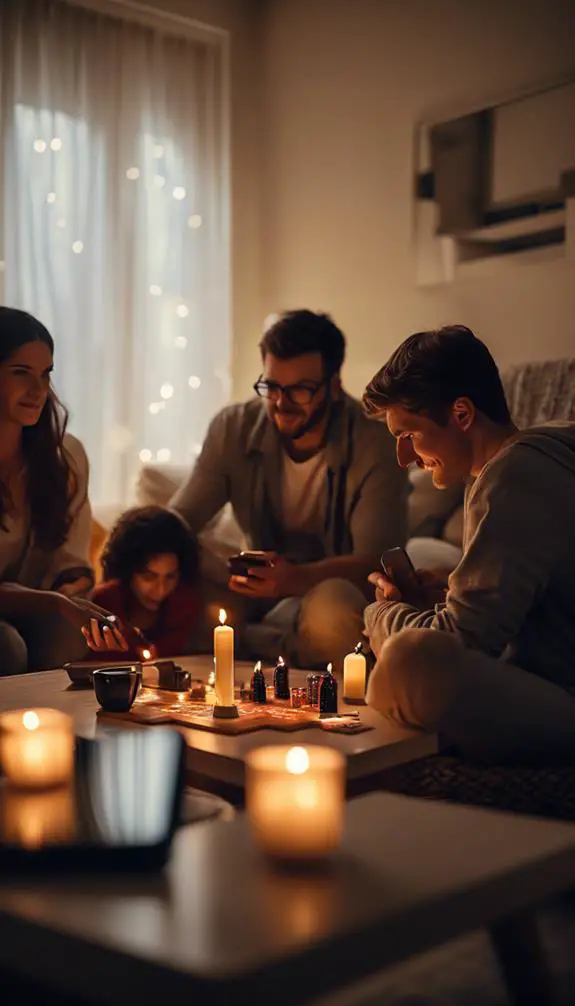
Your phone's battery life is a precious commodity during a power outage, and it's crucial to conserve it.
To stay connected, invest in a battery backup system or a portable power bank that can charge your phone multiple times. Consider purchasing a solar-powered phone charger or a hand-crank charger as an alternative.
These devices will guarantee you stay informed and connected with family and friends during an extended outage. Keep your phone's battery level above 50% when possible, and turn off unnecessary features like Bluetooth and Wi-Fi to prolong battery life.
With a backup plan in place, you'll be prepared to communicate and access important information when the grid goes down.
Plan for Alternative Cooking Methods

When the power goes out, you'll need a reliable way to cook meals.
Consider investing in a grill or camp stove, which can provide a convenient and portable cooking option. These alternatives will allow you to prepare hot meals even when your electric stove or oven are out of commission.
Grill and Camp Stove
Get ahead of the game by investing in a grill or camp stove as a plan B for cooking during a power outage.
When choosing a grill, consider a propane or charcoal model, and make sure you have a backup fuel source. For camp stoves, opt for a portable, multi-fuel option.
Always follow grill safety tips, such as keeping a fire extinguisher nearby and grilling at least 10 feet away from flammable structures.
If you don't have a grill or camp stove, consider alternatives like a solar oven or a portable electric stove with a battery backup. Remember to store your alternative cooking method in an easily accessible location, so you can quickly switch to plan B in case of an outage.
Portable Cooking Options
How far would you stretch to cook a hot meal during a prolonged power outage?
Having portable cooking options can be a lifesaver. Consider investing in camping grills or portable stoves that run on various fuel sources, such as propane, charcoal, or white gas.
These alternatives allow you to cook a hot meal even when the grid is down. Look for units with adjustable burners, windshields, and durable construction.
Don't forget to stock up on fuel sources and cooking accessories, like pots, pans, and utensils. With a portable cooking option, you'll be able to prepare meals on your own terms, even in the midst of a power outage, giving you a sense of freedom and independence.
Keep Your Devices Charged
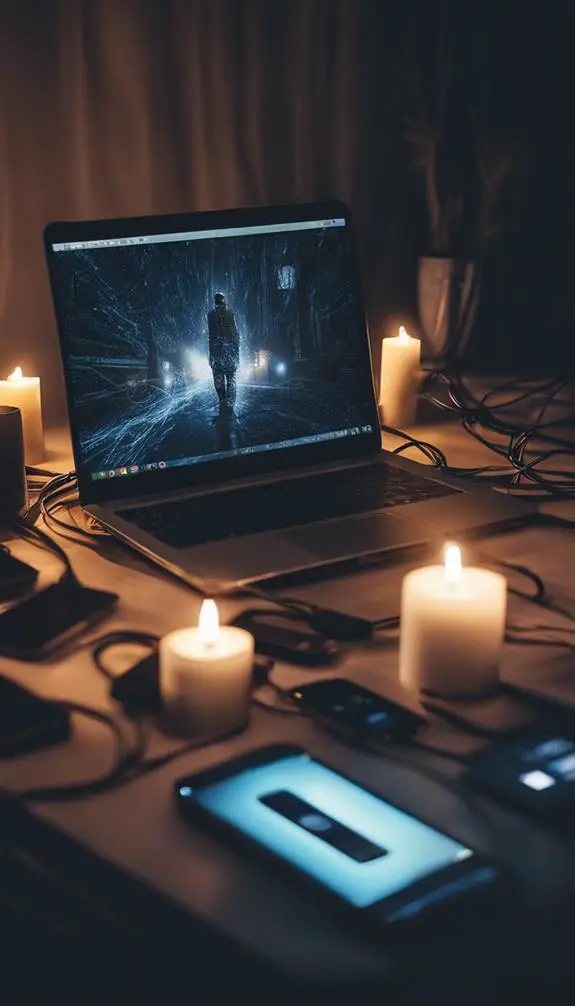
Your devices are your lifeline during a power outage, and keeping them charged is crucial.
Identify your device priorities, such as your phone, laptop, and any medical equipment.
Develop charging strategies to guarantee they stay powered up. Charge your devices whenever possible, especially when a storm is approaching.
Consider investing in a portable power bank or solar charger to extend battery life.
Keep your devices in low-power mode to conserve energy. Unplug them when fully charged to prevent overcharging.
Rotate your devices to maximize charging time, focusing on the most essential ones first.
Prepare Your Home for Outages
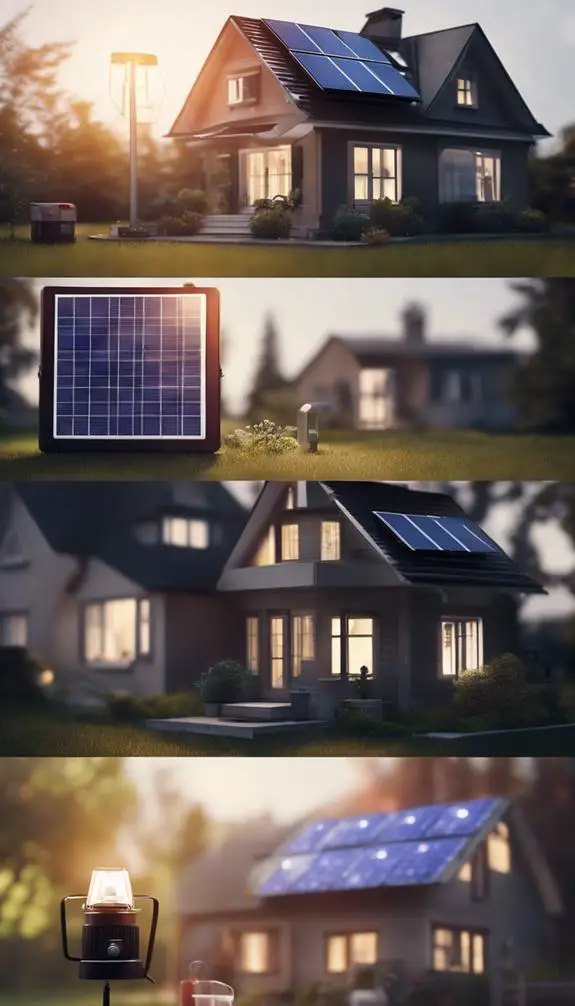
During the critical hours leading up to a power outage, take proactive steps to prepare your home.
Conduct a home inspection to identify potential electrical hazards, such as flickering lights or warm outlets, and address them promptly.
Consider electrical upgrades, like installing whole-house surge protectors or Arc Fault Circuit Interrupters, to safeguard your home from electrical fires.
Confirm that your electrical panel is easily accessible and clear of clutter.
Trim tree branches and shrubs around power lines to prevent them from causing outages.
Stay Informed With a Radio

Frequently, power outages strike without warning, and staying informed becomes crucial to navigate the situation safely.
You'll need a reliable means of staying up-to-date on the status of the outage, emergency instructions, and weather updates. A radio is an essential tool for this purpose.
You have two primary radio types to choose from: battery-powered and hand-crank radios. Both options guarantee you stay informed even when the power is out.
Look for a radio with multiple broadcast options, such as AM, FM, and NOAA (National Oceanic and Atmospheric Administration) Weather Radio. This will give you access to emergency alerts, news, and weather updates.
Make sure to test your radio regularly to verify it's functioning properly, and keep extra batteries on hand if you opt for a battery-powered model.
Practice Your Emergency Plan

Resilience is key to traversing a power outage, and it starts with a well-rehearsed emergency plan.
You've developed a plan, now it's time to put it into action. Conduct regular plan rehearsals to identify weaknesses and make adjustments.
Create drill scenarios that mimic potential power outage situations, such as a sudden loss of electricity or a prolonged outage. Practice your response, including communication protocols, evacuation procedures, and alternative lighting and heating sources.
Involve all household members to certify everyone knows their role. By rehearsing your plan, you'll build confidence and muscle memory, enabling you to respond efficiently and effectively during an actual power outage.
FAQs
Can I Use My Generator Indoors During a Power Outage?
Don't even think about running your generator indoors – it's a carbon monoxide nightmare waiting to happen. Prioritize generator safety by placing it outside, at least 20 feet away from windows and doors, to guarantee you're not trading power for poisoning.
How Often Should I Update My Emergency Kit Supplies?
You should regularly review your emergency kit's supply expiration dates, revitalizing your kit every 6-12 months to guarantee expired items are replaced, and updating supplies that may no longer be effective or relevant.
What if I Have Medical Equipment That Requires Electricity?
You're wise to weigh your medical equipment's power needs. Identify your medical priority devices, then invest in a reliable battery backup system, ensuring you have a sufficient power reserve to maintain their operation during an outage.
Can I Flush the Toilet During a Power Outage?
You can usually flush the toilet during a power outage, but it depends on your home's flush protocol and connection to the sewer system; if you're unsure, it's best to err on the side of caution and conserve water to avoid sewage backup.
How Long Can I Safely Store Water for Emergency Use?
You'll want to store water safely for emergency use; aim for a 1-year shelf life if you properly purify and store it in airtight, food-grade containers, ensuring peak water quality through regular rotation and purification methods.
Conclusion
You've taken vital steps to prepare for a power outage. Now, stay vigilant and review your emergency plan regularly. Update your kit as items expire or are used. Make sure your devices are fully charged, and your backup power sources are ready. With your preparations in place, you'll be better equipped to navigate an outage safely and confidently. Remember, preparedness is key to riding out a power outage with minimal disruption to your daily life.




